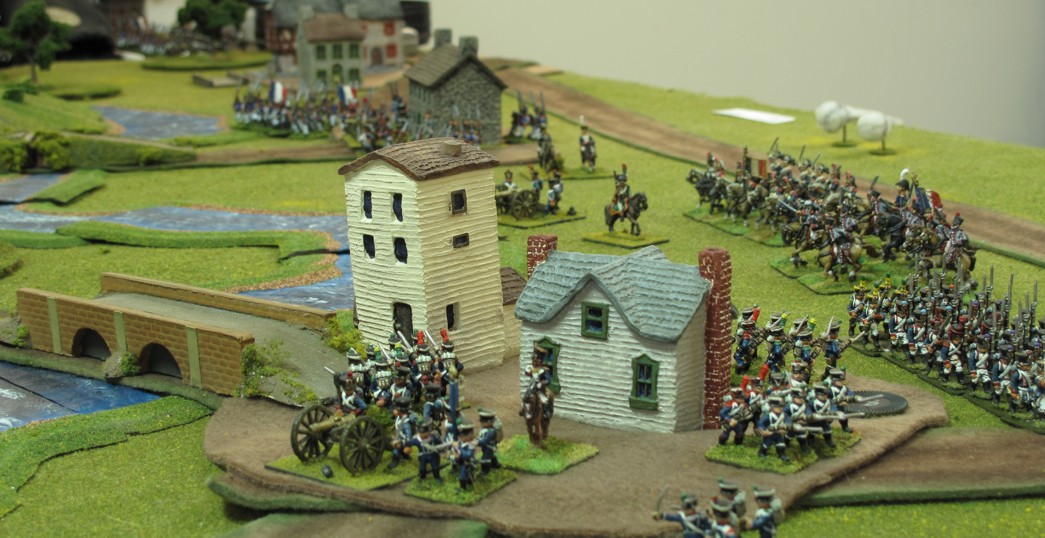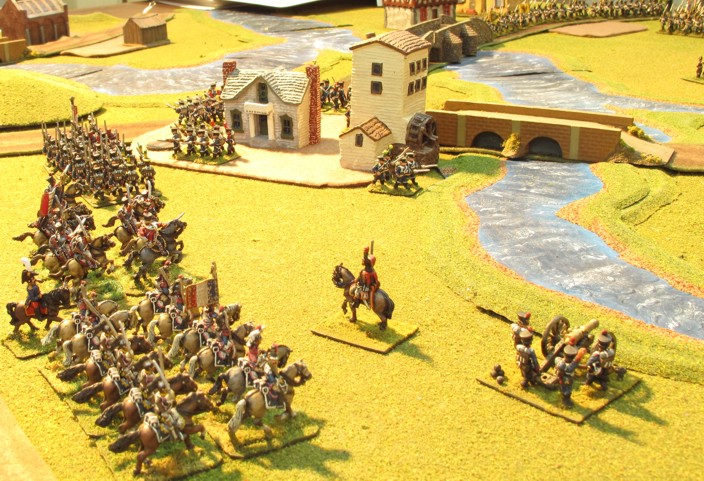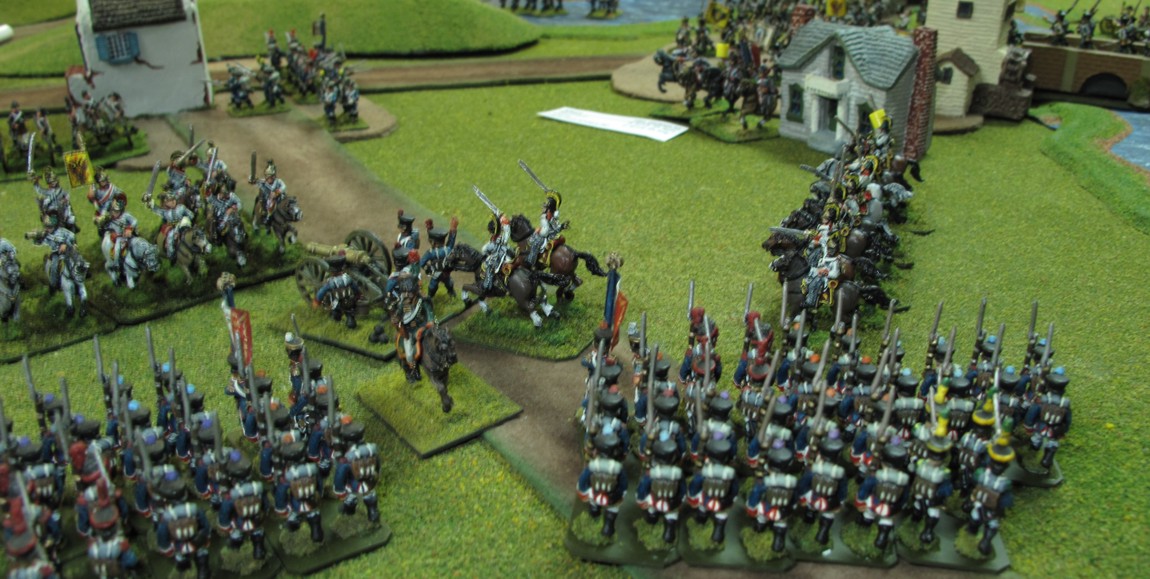In an attempt to guard Frances borders while he defeated the main Allied force (British and Prussians) Napoleon had stationed several “Observation Corps” on the most vulnerable approaches. On June 28th 1815 French General Rapp and 19,000 French infantry and around 2,000 cavalry squared off against Austrian Crown Prince Eugene, 34,000 infantry and 4,500 cavalry, this was the very last battle of the Napoleonic wars.
An English reporter for the London Times (Percy Wordsmith) sent this eye witness report while traveling with the Austrian army.
French troops had spent most of the early morning pushing civilians out of their homes and out of the villages. Other French units set to work clearing fields of fire building barricades, and improving their lines along the river until the scouting Hussar units galloped back across the bridges with reports of Austrian columns fast approaching. As the French hunkered down in their defensive positions the far side of the Souffel river bristled with the bayonets from half a dozen Austrian columns. Huge Austrian brigades nearly the size of French divisions maneuvered around each other in an attempt to quickly close with the French. The French artillery opened up on these columns, seldom causing real damage but throwing them into disorder and slowing them down. In the center Austrian heavy cavalry pushed to the center causing the French horse batteries to withdraw and French heavy cav to counter the move in order to guard the flanks of both towns.

Austrian commanders position their supporting Artillery battery’s with a cheer ans a “Hats off” salute!
Austrian forces in the center had finally started to push across the bridges but were repulsed at both crossings by stubborn French resistance losing a few troops along the way. The Austrians retreated back across the bridges to regroup and await the redeployment of their gun batteries in a better supporting position. Over two hours had passed by now and as general Rapp anticipated the Austrians had detected his weak undefended left flank. Reports of Austrian cavalry and guns crossing there in force were now coming into his headquarters, Rapp quickly dispatched an ADC to Colonel Merlin commanding the French cavalry to move west to block the Austrian flanking move. Rapp also gave orders to send a brigade from each of his other divisions to also move into a blocking position to the west allowing his cav to resume their job as a mobile reserve in the center.
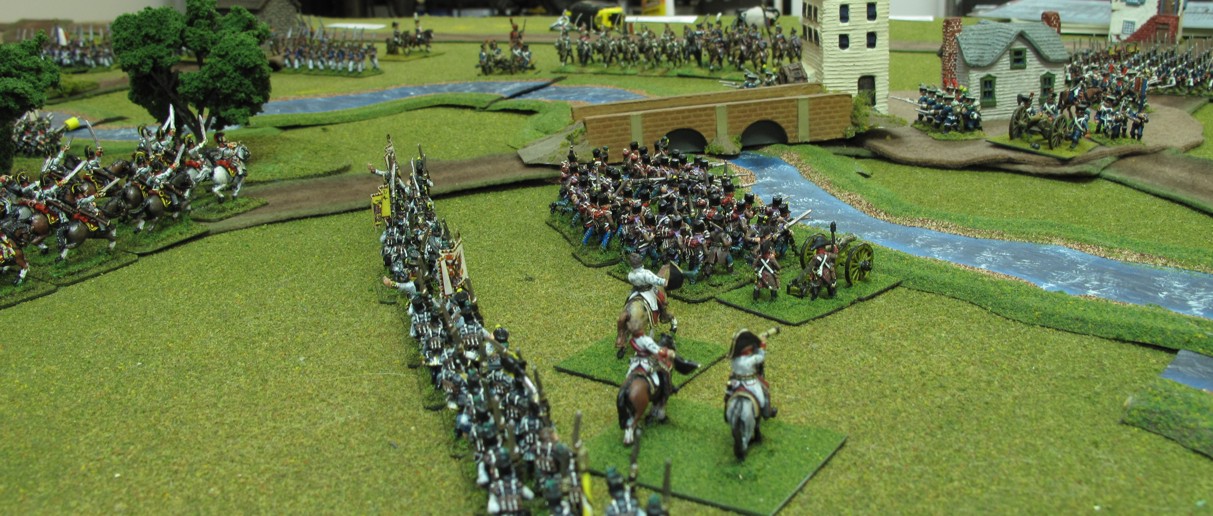
Austrians mass and move to the assault. Austrian Cav gives french Cav something to think about in the center.
The Austrian commanders however had planned this diversionary attack on the French left flank to do just exactly what it had done, weaken the center, and they choose that moment to launch a renewed assault, a much more coordinated, powerful, attack. The Austrian batteries roared, slamming shell after shell into the French defenders. The French defense remained firm and the artillery had little effect but that of making a shambles of the town. Now over the bridges came the renewed attack of the Austrians, two brigades now reformed into assault columns (thanks AOE Yahoo group) and combining their numbers for the assault against the small French brigade left in town.
On the eastern side of the battlefield the Austrians were finally sorting out the traffic jams caused by their massive and unwieldy brigades. One of the Austrian brigades charged forward across the bridge but suffered the same results as the Austrian attacks across the bridges there. The eastern Austrian push settled down to an artillery dual with the Austrian commander waiting for developments elsewhere on the field. To the west the French and Austrian forces squared off and waited for one another other to see make the first move.

Austrian troops across the river at Souffelweyersheim spend most of the battle just tossing angry shouts and an occasional cannon ball at the French.
The center now erupted into pitched battle over the bridges of Mundolsheim and again the Austrian dragoons once attempted to cross the Souffel in the center, succeeding in causing the French cavalry to move back from their blocking position in the east to the center, again countering the Austria dragoons. This time the Austrians Dragoons charged, the French Hussars counter charged and after a brutal fight the weight of Austrian heavy cav succeeded in crushing the French Hussars. The Austrian commander had watched intently this clash and was now joyous with the possibility of splitting the French center and even falling onto the rear of the French line to the west. However he had no cavalry reserve to push across the center and the Dragoons were far from fresh. The Austrian Dragoons sensing that this was the moment, their moment shook off their disorder and preparing too charge the rear of the French defenders to the west.
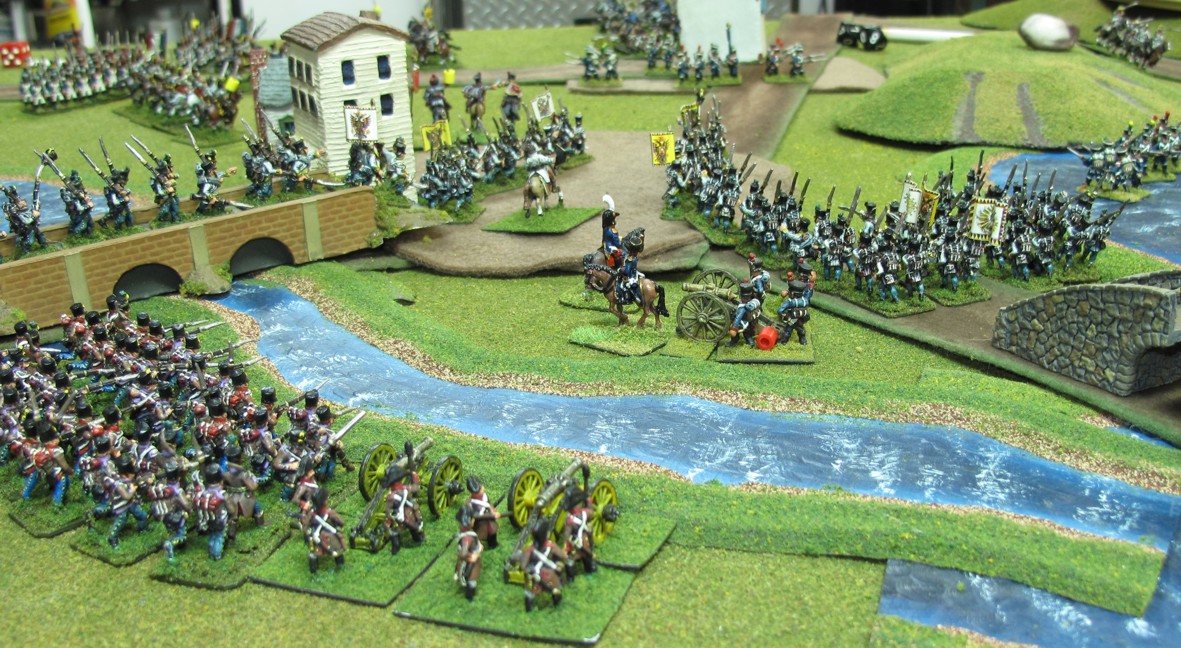
Austrian columns assault and shatter the french center, the french Officers and gun battery in the picture have been “captured” survivors flee to the rear.
Meanwhile the Austrian infantry attack on the French center had succeeded in forcing the crossings, nearly destroying the defending French brigade, the French losing two regiments, their guns and their commanding general captured, the remnants falling back out of the town.

The final positions just before dark and the close of the Battle. French / Yellow, Austrians / Orange
The Austrians now sensed the French were in trouble and pressed on, their infantry columns flooding through and out of the town in pursuit, forming up in line of battle preparing to roll up the French left flank. Once again as they had done several times already this battle French forces despite being of less than normal quality (50% of the infantry were conscripts) rose up in defiance and struck back.
The French reserves had finally arrived in the center and deployed with a heavy battery with in effective range of the reforming Austrian dragoons and just as they were about to charge, delivered a devastating combined volley killing several stands, throwing the Austrian dragoons back into disorder, and pinning them in place where they stood till they died. A small victory for the French but it had little effect overall the Austrians had pushed back the french left flank and now four huge Austrian brigades had were in position to move forward taking the rest of the French positions in the flank or rear…. Fate and darkness intervened at this point with the battle ending at 7:30 pm. General Rapp ordered skirmish screens and a general withdrawal towards Strasbourg.
From the Austrian camp,
Percy Wordsmith, London Times
When the victory points were added up the French were ahead, coupling that with their success in keeping at preventing the Austrians from archiving a quick crossing of the Souffel and possibly trapping Rapps main force gave the French an overall win. Herr Gausche playing the part of Archduke John did a splendid job in forcing the river crossing against a determined opponent. We learned how to do a few things within the rules that we had not come across before. Once again the “Age of Eagles” rules rose up and proved to be equal to the task and provided us with one of the best Napoleonic battles yet played by us over the years.
Rules: Age of Eagles (AOE) by Bill Gray from Fire and Fury
Scenario courtesy of the Susquehanna war-gaming group
French, 5 Commanders, 50 infantry stands, 11 Cavalry stands, 4 Batteries
Austrians, 6 Commanders, 90 Infantry Stands, 25 Cavalry stands.

